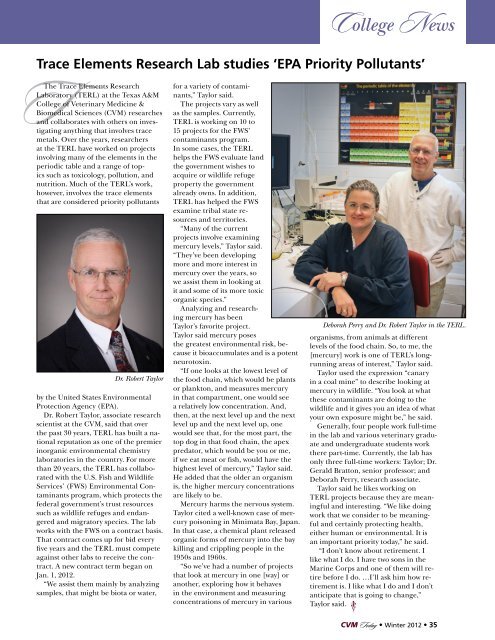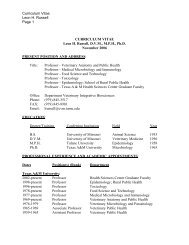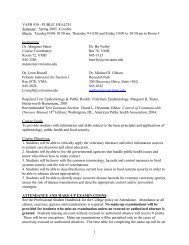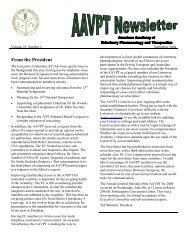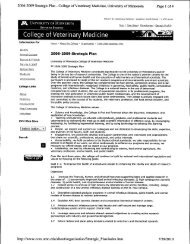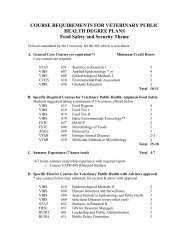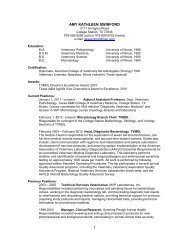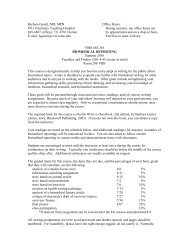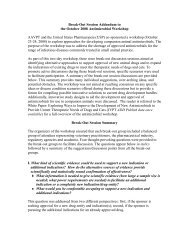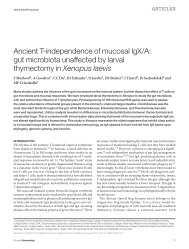Download PDF - College of Veterinary Medicine - Texas A&M ...
Download PDF - College of Veterinary Medicine - Texas A&M ...
Download PDF - College of Veterinary Medicine - Texas A&M ...
Create successful ePaper yourself
Turn your PDF publications into a flip-book with our unique Google optimized e-Paper software.
<strong>College</strong> News<br />
Trace Elements Research Lab studies ‘EPA Priority Pollutants’<br />
The Trace Elements Research<br />
Laboratory (TERL) at the <strong>Texas</strong> A&M<br />
<strong>College</strong> <strong>of</strong> <strong>Veterinary</strong> <strong>Medicine</strong> &<br />
Biomedical Sciences (CVM) researches<br />
and collaborates with others on investigating<br />
anything that involves trace<br />
metals. Over the years, researchers<br />
at the TERL have worked on projects<br />
involving many <strong>of</strong> the elements in the<br />
periodic table and a range <strong>of</strong> topics<br />
such as toxicology, pollution, and<br />
nutrition. Much <strong>of</strong> the TERL’s work,<br />
however, involves the trace elements<br />
that are considered priority pollutants<br />
Dr. Robert Taylor<br />
by the United States Environmental<br />
Protection Agency (EPA).<br />
Dr. Robert Taylor, associate research<br />
scientist at the CVM, said that over<br />
the past 30 years, TERL has built a national<br />
reputation as one <strong>of</strong> the premier<br />
inorganic environmental chemistry<br />
laboratories in the country. For more<br />
than 20 years, the TERL has collaborated<br />
with the U.S. Fish and Wildlife<br />
Services’ (FWS) Environmental Contaminants<br />
program, which protects the<br />
federal government’s trust resources<br />
such as wildlife refuges and endangered<br />
and migratory species. The lab<br />
works with the FWS on a contract basis.<br />
That contract comes up for bid every<br />
five years and the TERL must compete<br />
against other labs to receive the contract.<br />
A new contract term began on<br />
Jan. 1, 2012.<br />
“We assist them mainly by analyzing<br />
samples, that might be biota or water,<br />
for a variety <strong>of</strong> contaminants,”<br />
Taylor said.<br />
The projects vary as well<br />
as the samples. Currently,<br />
TERL is working on 10 to<br />
15 projects for the FWS’<br />
contaminants program.<br />
In some cases, the TERL<br />
helps the FWS evaluate land<br />
the government wishes to<br />
acquire or wildlife refuge<br />
property the government<br />
already owns. In addition,<br />
TERL has helped the FWS<br />
examine tribal state resources<br />
and territories.<br />
“Many <strong>of</strong> the current<br />
projects involve examining<br />
mercury levels,” Taylor said.<br />
“They’ve been developing<br />
more and more interest in<br />
mercury over the years, so<br />
we assist them in looking at<br />
it and some <strong>of</strong> its more toxic<br />
organic species.”<br />
Analyzing and researching<br />
mercury has been<br />
Taylor’s favorite project.<br />
Taylor said mercury poses<br />
the greatest environmental risk, because<br />
it bioaccumulates and is a potent<br />
neurotoxin.<br />
“If one looks at the lowest level <strong>of</strong><br />
the food chain, which would be plants<br />
or plankton, and measures mercury<br />
in that compartment, one would see<br />
a relatively low concentration. And,<br />
then, at the next level up and the next<br />
level up and the next level up, one<br />
would see that, for the most part, the<br />
top dog in that food chain, the apex<br />
predator, which would be you or me,<br />
if we eat meat or fish, would have the<br />
highest level <strong>of</strong> mercury,” Taylor said.<br />
He added that the older an organism<br />
is, the higher mercury concentrations<br />
are likely to be.<br />
Mercury harms the nervous system.<br />
Taylor cited a well-known case <strong>of</strong> mercury<br />
poisoning in Minimata Bay, Japan.<br />
In that case, a chemical plant released<br />
organic forms <strong>of</strong> mercury into the bay<br />
killing and crippling people in the<br />
1950s and 1960s.<br />
“So we’ve had a number <strong>of</strong> projects<br />
that look at mercury in one [way] or<br />
another, exploring how it behaves<br />
in the environment and measuring<br />
concentrations <strong>of</strong> mercury in various<br />
Deborah Perry and Dr. Robert Taylor in the TERL.<br />
organisms, from animals at different<br />
levels <strong>of</strong> the food chain. So, to me, the<br />
[mercury] work is one <strong>of</strong> TERL’s longrunning<br />
areas <strong>of</strong> interest,” Taylor said.<br />
Taylor used the expression “canary<br />
in a coal mine” to describe looking at<br />
mercury in wildlife. “You look at what<br />
these contaminants are doing to the<br />
wildlife and it gives you an idea <strong>of</strong> what<br />
your own exposure might be,” he said.<br />
Generally, four people work full-time<br />
in the lab and various veterinary graduate<br />
and undergraduate students work<br />
there part-time. Currently, the lab has<br />
only three full-time workers: Taylor; Dr.<br />
Gerald Bratton, senior pr<strong>of</strong>essor; and<br />
Deborah Perry, research associate.<br />
Taylor said he likes working on<br />
TERL projects because they are meaningful<br />
and interesting. “We like doing<br />
work that we consider to be meaningful<br />
and certainly protecting health,<br />
either human or environmental. It is<br />
an important priority today,” he said.<br />
“I don’t know about retirement. I<br />
like what I do. I have two sons in the<br />
Marine Corps and one <strong>of</strong> them will retire<br />
before I do. …I’ll ask him how retirement<br />
is. I like what I do and I don’t<br />
anticipate that is going to change,”<br />
Taylor said.<br />
CVM Today • Winter 2012 • 35


